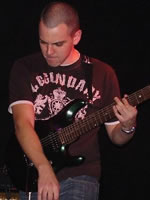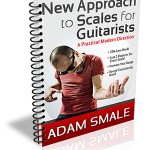As a teacher, it is apparent that most player’s primary concern’ when improvising or writing a solo’ is note choice, what scales work over what chord etc. It is very rare that any consideration is placed on how they should play something rhythmically. If I ask a student to play a very simple four-note pentatonic phrase and then alter it, 99.9 % of the time they will change the order of the notes, not the rhythm. This becomes more apparent when it comes to ‘shredding’, the word that is used in the guitar world for playing anything quickly.

Lewis Turner
Most of the technical things that are practiced to a metronome are either played as three notes per beat triplets, four notes per beat sixteenth notes, or six notes per beat sixteenth note triplets, and, as you develop your technique, this is a good idea because all of these groupings sit nicely when playing to a standard metronome click. However, when you are improvising, you are creating music and trying to hold the listener’s interest by avoiding the dreaded boring souless ‘widdle’ factor that has become associated with shred players.
The idea of this series of lessons is to look at playing in a more progressive way. Odd-note groupings, rhythmic displacement, polyrhythms, and odd time signatures are going to be the order of the day. I will be taking all the usual shred techniques, alternate picking, sweeping, legato, tapping and economy picking and looking at practicing them in a more unusual and challenging way as well as using them in a more musical context before eventually building up to a complete solo. If you have mastered the aforementioned techniques and are looking for a new challenge or want to spice up your playing, then read on.
Progressive rock/metal music is music that doesn’t stick to the usual ‘rules’ of the pop world. Songs are often long with lots of different parts; changes in time signature; keys and feature virtuoso performances from various individual band members. Bands like Rush, King Crimson, Nevermore, Meshuggah, Opeth and Dream Theater have made this type of music very popular, and you can hear their influence on the modern progressive bands that are coming out today. The guitarists in these bands also have the ability to solo over complex time changes in a musical way. Even if you are not into progressive music or ‘technical’ playing, this series will help spice things up by getting you to see that rhythm is just as important as note choice.
Alternate picking is the most economical way to pick on a single string and, when used across all the strings in a fast way, generates a very powerful sound, attack and feel; completely different to that of legato. It is usually the first technique you work on and gets the two hands working in tight synchronisation. I believe it’s the very backbone of good technique. Master this, and all the other techniques will follow a lot easier. To get a good picking sound, you will need to use a good thick pick nothing below 1mm, because a pick that flexes wastes time and energy. I would recommend that you hold the pick between your thumb and first finger and rest the side of your picking hand on the idle bass strings to stop any dreaded open-string drones. Try to create an O with you thumb and first finger and show only a small amount of pick to the string. This will help to prevent your thumb and finger from locking into position. Try to do as much of your picking from the wrist and a slight amount of thumb and finger motion.
This first lesson is devoted to picking in groups of five, quintuplets have five notes per beat. Set your metronome to a relatively slow speed say about 65 bpm and just practice picking a single string five times in one beat. There are certain ways of counting groups of notes, for triplets you count, “one and a two and a”; sixteenths, “one e and a two e and a”; however, it can be more difficult to play odd-note groupings, especially at high speeds. At low speeds it is possible to count 1 2 3 4 5 1 2 3 4 5 etc and I would recommend this until it starts to become more natural to you, because counting that at 200 bpm is impractical, and becomes more of a feel thing! In later lessons we will be looking at playing in other groupings like seven and eleven, but for the time being just try and get groups of five to become second nature. Some musicians use what’s called a syllabic form of counting, whereby they use certain words. For example, for quintuplets, the Carnatic musical tradition of India would verbalise (or just think) “ta di kin a thom”.
| Resources for Exercise 1, 2 & 3 – © Lewis Turner | |
|---|---|
| Alternate Picking Part 1 – Exercise 1, 2 & 3 (58KB pdf) | |
This is a good one to get you used to groups of five. Notice how in every exercise the first note of each five-note group should be accented, this is very important because, as you get up to higher speeds, it will give more definition to your lines, rather than produce a wash of notes that gets lost in the mix. Your aim in this exercise is that every A note should land on the click. Also notice that, because we are playing an odd number of notes, the direction of your pick changes each time on the A note. The first time is a down-stroke; the second time is an up-stroke etc. This can be quite a challenge, but you need to make sure that your up-picks are as strong as your down. Make sure that you stick to strict alternate picking.
This is an extension of EXERCISE 1. We now move this lick up the neck in the key of A minor. Watch out for the shape changes on the second string and, again, accent each note on the E string. End with tone-wide slow vibrato for that true metal sound!
This is a single-string lateral shift using A harmonic minor. This kind of lick is very popular with players like Yngwie Malmsteen, but here we have it in groups of five to make it a bit more rhythmic interest. Using this key makes some of the fingerings and stretches a little tricky when you get up to the twelfth fret. If you experience difficulty with this, just try isolating one area and doing it over and over to a metronome click. When doing these lateral shifts, try looking ahead to where you want to go next, not at what you are doing at that moment, this will help you avoid landing one fret short or one fret too far. Also, make sure that your picking movement is as small as possible. To get quicker, try moving your pick less rather than faster.
| Resources for Exercise 4, 5 & 6 – © Lewis Turner | |
|---|---|
| Alternate Picking Part 1 – Exercise 4, 5 & 6 (60KB pdf) | |
| Alternate Picking Part 1 – Exercise 6 – SLOW example (1.7MB MP3) | |
|
Audio clip: Adobe Flash Player (version 9 or above) is required to play this audio clip. Download the latest version here. You also need to have JavaScript enabled in your browser. |
|
| Alternate Picking Part 1 – Exercise 6 – SLOW full backing track (2.2MB MP3) | |
|
Audio clip: Adobe Flash Player (version 9 or above) is required to play this audio clip. Download the latest version here. You also need to have JavaScript enabled in your browser. |
|
| Alternate Picking Part 1 – Exercise 6 – MEDIUM example (1.4MB MP3) | |
|
Audio clip: Adobe Flash Player (version 9 or above) is required to play this audio clip. Download the latest version here. You also need to have JavaScript enabled in your browser. |
|
| Alternate Picking Part 1 – Exercise 6 – MEDIUM full backing track (1.7MB MP3) | |
|
Audio clip: Adobe Flash Player (version 9 or above) is required to play this audio clip. Download the latest version here. You also need to have JavaScript enabled in your browser. |
|
| Alternate Picking Part 1 – Exercise 6 – FAST example (1.1MB MP3) | |
|
Audio clip: Adobe Flash Player (version 9 or above) is required to play this audio clip. Download the latest version here. You also need to have JavaScript enabled in your browser. |
|
| Alternate Picking Part 1 – Exercise 6 – FAST full backing track (1.5MB MP3) | |
|
Audio clip: Adobe Flash Player (version 9 or above) is required to play this audio clip. Download the latest version here. You also need to have JavaScript enabled in your browser. |
|
This is an octave position-shift lick from A harmonic minor, but could also be viewed as E Phrygian Dominant. This is the first lick in a different time signature to 4/4. 3/4 is not a particularly odd time signature and is often associated with waltz music, but it can also be used in rock music with good effect. In this case, it gives each phrase a bit of an unfinished feel to it. Watch your picking; if you are alternate picking correctly, you should start the third string with an up-pick and the fifth with a down-stroke.
This is a chromatic exercise in 2/4. I like chromatic lines, and use them a lot. They give quite a modern, different and unique sound, and are great for practising technique, as you get to work all of your fretting-hand fingers. If you are not used to chromatics, this may feel a little awkward, but stick with it, and try it very slow, watching which notes the accents fall on. 2/4 time signatures are often used alongside 4/4. A typical example would be four bars of 4/4, one bar of 2/4 and then back to 4/4. It can give the impression of a skipping CD, even though it is all just straight time.
This last one is another chromatic idea. This is quite a tough one. Take your time and make sure all of your notes are nice and clear. If you find you can do this okay, try extending it up the chromatic scale to the first string. The string-skip from the third string to the first will prove even more of a challenge. On the audio files attached you will hear each example played to a backing track at a slow, medium and fast tempo followed by a corresponding backing track for you to try the exercises over.
Finally, remember these are just exercises to develop your technique in this area. Try experimenting with them, and use them in a musical way with your own ideas.
All content © Lewis Turner – For more information about Lewis Turner, please visit:






















Lewis Turner is a highly accomplished guitarist, with years of performing, recording, session and teaching experience. Lewis performs all over the UK and abroad with various bands as well as Theatre, TV and Radio work

4:40:01 pm
Thanks for the fantastic first lesson Lewis. All I need to do is break out my SG and get to grips with some of those exercises… give me another 15 years and I may be able to attempt the fast exercise in Exercise 6 😉 Nice one
1:21:34 pm
Cheers for posting – this stuff usually costs!